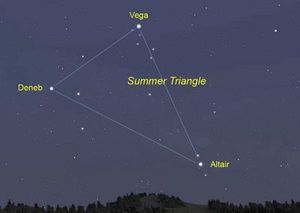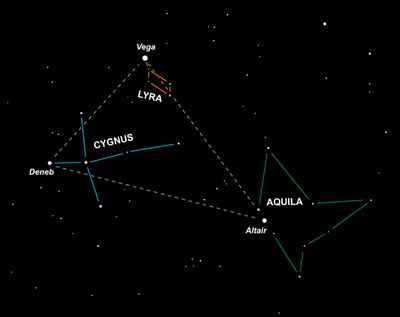The first thing I do when I get out in the dark night with my telescope is get oriented. They best way to do that is find the "Summer Triangle". The summer triangle consists of three bright stars from three constellations. There are a lot of great things to see in the area of these three since they are in the direction of the Milkyway. The triangle should be almost directly overhead in the summer.

Once you find the summer triangle you can discern the three constellation that it's three stars belong too. There are some great bjects to be found in this area, Some like the blue and gold double star Albeiro are very easy objects to find.

Cygnus
Cygnus, the Swan, is also known as the Northern Cross because of its distinctive shape. The tail of the swan is marked by the bright star Deneb, Arabic for "tail". Three fainter stars cross the line between Deneb and the head of the swan, Albireo. Albireo is a beautiful double star of blue and gold at the nose of the swan Cygnus. Cygnus flies southward along the summer Milky Way, and into the Summer Triangle.
- Messier 29 (M29) - An open cluster located in the Cygnus constellation. It is a small but bright cluster, found near the star Gamma Cygni.
- Messier 39 (M39) - Another open cluster located in the Cygnus constellation. It is larger and more dispersed than M29, located near the star Pi-2 Cygni.
Lyra
Lyra's name is derived from the lyre, a stringed musical instrument well known for its use in classical antiquity and later. Lyra is a small constellation, but its principal star, Vega, is one of the brightest in the sky. Like a smoke ring in the heavens, the Ring Nebula can be found in the parallelogram of Lyra. It is one of the brightest nebulas and can be seen in a small telescope.
- Messier 56 (M56) - This is a globular cluster located in the constellation of Lyra. It lies approximately 32,900 light-years away from Earth.
- Messier 57 (M57) - Also known as the Ring Nebula, M57 is one of the most famous planetary nebulae in the sky. It is located in the constellation of Lyra and is about 2,300 light-years away from Earth.
Aquila
Aquila is a constellation. Its name is Latin for 'eagle' and it is commonly represented as such. It lies roughly at the celestial equator. The alpha star, Altair, is a vertex of the Summer Triangle asterism.
- Messier 11 (M11) - The Wild Duck Cluster
- Type: Open Cluster
- Constellation: Scutum (near Aquila)
- Description: One of the richest and most compact open clusters known, M11 is situated in the constellation Scutum, which is adjacent to Aquila.
- Messier 26 (M26)
- Type: Open Cluster
- Constellation: Scutum (near Aquila)
- Description: M26 is another open cluster located in the constellation Scutum, not far from Aquila.
Sagittarius
Sagittarius is one of the constellations of the zodiac. Its name is Latin for the archer, and its symbol is (Unicode ?), a stylized arrow. Sagittarius is commonly represented as a centaur drawing a bow. It lies between Ophiuchus to the west and Capricornus to the east.
- M8 (Lagoon Nebula) - A large, bright emission nebula, also known as NGC 6523.
- M17 (Omega Nebula or Swan Nebula) - Another bright emission nebula, also known as NGC 6618.
- M18 Open Cluster - An open cluster of stars.
- M20 (Trifid Nebula) - A combination of an emission nebula, reflection nebula, and dark nebula.
- M21 Open Cluster - An open star cluster located near the Trifid Nebula.
- M22 (Great Sagittarius Cluster) - One of the brightest and most prominent globular clusters in the sky.
- M23 (Open Cluster) - A large, rich open cluster of stars.
- M24 (Sagittarius Star Cloud) - A dense star cloud within the Milky Way, sometimes referred to as the Small Sagittarius Star Cloud.
- M25 (Open Cluster) - A large, bright open star cluster.
- M28 (Globular Cluster) - A globular cluster of stars.
- M54 (Globular Cluster) - A globular cluster, now thought to belong to the Sagittarius Dwarf Spheroidal Galaxy.
- M55 (Globular Cluster) - A relatively diffuse globular cluster.
- M69 (Globular Cluster) - A small but bright globular cluster.
- M70 - Another globular cluster, similar in appearance to M69.
- M75 - A distant globular cluster that is more condensed than most.
Scorpius
Scorpius is one of the constellations of the zodiac; the associated astrological sign is called Scorpio. Its name is Latin for scorpion. It lies between Libra to the west and Sagittarius to the east. It is a large constellation located in the southern hemisphere near the center of the Milky Way.
- Messier 4 (M4) - A globular cluster located near the bright star Antares in the constellation Scorpius.
- Messier 6 (M6) - Also known as the Butterfly Cluster, this is an open cluster located in the Scorpius constellation.
- Messier 7 (M7) - Also known as Ptolemy's Cluster, this is another open cluster located near the tail of the Scorpius constellation.
